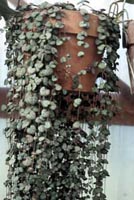Resource Library
Plant of the Week: Vine, String of Hearts (Heart Vine, Rosary Vine)
The University of Arkansas System Division of Agriculture does not promote, support or recommend plants featured in "Plant of the Week." Please consult your local Extension office for plants suitable for your region.
Plant of the Week
String of Hearts Vine, Heart Vine, Rosary Vine
Latin: Ceropegia woodii

Every holiday has a plant associated with it -- in fact there may be several.
The obvious one for Valentine’s Day would be roses, but being obvious is no fun.
The string of hearts vine, though far from traditional Valentine’s Day fare, will
have an appeal with gardeners wishing to remember the sentiment of a lover’s holiday
long after roses have withered away. Of course it goes without saying, my wife would
prefer roses.
String of hearts vine is a trailing vine from South Africa and Zimbabwe that is a
member of the milkweed family. It produces long, thin trailing stems that have widely
spaced, opposite, heart shaped leaves that are about an inch long and wide. The leaves
are succulent with cyclamen-like markings of silver on the bluish-green upper leaf
surface. The lower leaf surface is gray-green to purple.
The vines can be three or more feet long. Along the stem is produced a series of
swollen tubercles that vary from pea size to an inch across. These round structures
give the plant its common name of Rosary Vine. These swollen structures will root
readily if in contact with the soil and are an easy way of propagating the plant.
In midwinter, older plants will flower, producing what can best be described as lantern-like
flowers. It’s not your average Coleman camping lantern, but the type with the small
base and long, tapered globe. The name for the genus is from Greek and translates
as "wax fountain" -- an allusion to the peculiar waxy flowers borne en mass along
the stems. The narrow tube of the flower is about an inch long and flesh colored,
with the petals brownish where they fuse at the tips.
Succulents, and especially their thorny brethren the cacti, provoke strong reaction
among gardeners. For some reason completely unfathomable to me, some people don’t
like them; you might even go so far to say they hate them. What I find fascinating
about these plants is their varied forms of adaptation that allow them survive in
really difficult conditions. A short, ugly guy I went to high school with was always
getting in fights and spent a lot of time in the principal’s office. His comment was,
"Hey -- when you’re ugly you gotta be tough to survive." Though I never thought of
him as a naturalist or philosopher, he seems to have hit upon a truism in nature.
The string of hearts vine is easy to grow in any sunny window. It is on the small
side, so is usually grown in a 4-inch pot, but if several plants are combined, it
can be grown in a small hanging basket. Plants should be kept uniformly moist during
the summer months and then allowed to dry down between waterings in the winter. Mealybugs
are sometimes problems on the plant but can be controlled easily by using a cotton
swab dipped in rubbing alcohol.
By: Gerald Klingaman, retired
Extension Horticulturist - Ornamentals
Extension News - February 18, 2000
The University of Arkansas System Division of Agriculture does not maintain lists of retail outlets where these plants can be purchased. Please check your local nursery or other retail outlets to ask about the availability of these plants for your growing area.